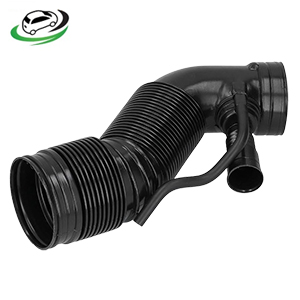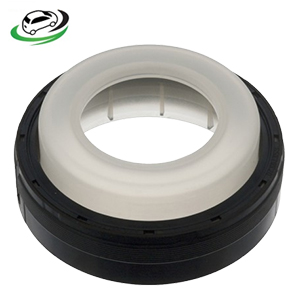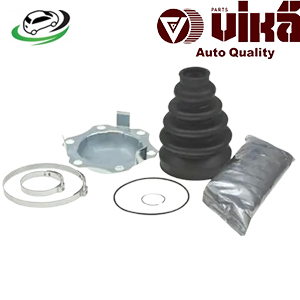-19%
Get Inner Front Driveshaft Boot Kit Audi TT/A4/A3/A2 / Volkswagen Polo Sedan/Polo/New Beetle/Jetta/Jetta Variant/Lupo 1J0498201D
The driveshaft boot kit is an essential component of a vehicle’s drivetrain, designed to protect the driveshaft’s universal joints (U-joints) or constant velocity (CV) joints. It ensures that these critical parts remain lubricated and free from contaminants, which is vital for the proper functioning of the drivetrain. This guide provides a detailed overview of the driveshaft boot kit, including its purpose, design, common issues, and maintenance practices.
1. Purpose and Function of the Driveshaft Boot Kit
The driveshaft boot kit is designed to safeguard the joints within the driveshaft assembly, which are crucial for transmitting torque from the engine to the wheels. Its primary functions include:
1.1. Protecting Joints
- Dust and Debris Protection: The driveshaft boot, typically made from rubber or synthetic materials, covers the joints to protect them from dirt, dust, water, and other contaminants that could cause wear or damage.
- Lubrication Retention: The boot kit helps retain the lubricating grease within the joints. This lubrication is essential for smooth operation and longevity of the joints.
1.2. Preventing Joint Wear
- Wear Reduction: By keeping contaminants out and maintaining proper lubrication, the driveshaft boot helps reduce friction and wear on the joints. This contributes to the longevity and reliability of the driveshaft assembly.
- Performance Maintenance: Properly functioning joints ensure efficient torque transmission and vehicle performance. A well-maintained driveshaft boot kit helps maintain smooth acceleration and handling.
1.3. Enhancing Safety
- Avoiding Failures: A damaged or leaking boot can lead to joint failure, which can cause driveline vibrations, noise, and potentially catastrophic damage. The boot kit helps prevent such failures by maintaining joint integrity.
2. Design and Structure of the Driveshaft Boot Kit
The driveshaft boot kit consists of several key components designed to ensure effective protection and lubrication of the driveshaft joints:
2.1. Key Components
- Boot: The boot is the flexible, often rubber or synthetic cover that encases the joint. It is designed to withstand extreme temperatures, pressure, and movement. The boot is usually held in place by clamps or bands.
- Clamps/Bands: Clamps or bands secure the boot to the driveshaft and joint. They ensure that the boot remains in position and prevents it from becoming dislodged or leaking.
- Grease: The kit includes grease specifically formulated for the joints. This grease lubricates the joints and ensures smooth movement.
2.2. Types of Boots
- Rubber Boots: Traditional rubber boots are durable and flexible, designed to accommodate the movements of the driveshaft while providing effective protection against contaminants.
- Synthetic Boots: Modern synthetic materials, such as polyurethane or thermoplastic elastomers (TPE), offer enhanced durability, heat resistance, and flexibility compared to traditional rubber.
2.3. Installation and Mounting
- Mounting Points: The boot is mounted over the joint and secured with clamps or bands. Proper alignment and secure attachment are essential for effective protection and lubrication.
- Installation Process: Installing the boot involves removing the old boot (if replacing), cleaning the joint, applying fresh grease, positioning the new boot, and securing it with clamps.
3. Common Issues with Driveshaft Boot Kits
Over time, the driveshaft boot can experience various issues that may affect its performance and the drivetrain’s operation. Common problems include:
3.1. Wear and Damage
- Cracking and Splitting: The boot can develop cracks or splits due to exposure to heat, road chemicals, and physical wear. This can lead to contamination of the joint and loss of lubrication.
- Tears and Holes: Physical damage, such as tears or punctures, can occur from debris or impacts. This can allow contaminants to enter and cause joint damage.
3.2. Grease Leakage
- Seal Failure: If the boot becomes damaged or the clamps are not properly secured, grease can leak out. This reduces the lubrication available for the joint and can lead to increased wear and potential failure.
- Reduced Lubrication: Insufficient grease in the joint can cause excessive friction, leading to overheating and wear.
3.3. Joint Damage
- Contaminant Ingress: When the boot is compromised, contaminants can enter the joint, leading to accelerated wear and potential joint failure. This can cause driveline vibrations, noise, and handling issues.
4. Maintenance and Replacement
Proper maintenance and timely replacement of the driveshaft boot kit are essential for ensuring the longevity and performance of the driveshaft assembly.
4.1. Inspection
- Visual Check: Regularly inspect the driveshaft boots for signs of damage, such as cracks, tears, or splits. Check the clamps for proper tightness and look for any signs of grease leakage.
- Grease Levels: Monitor the condition of the grease around the joints. If there are signs of leakage or reduced lubrication, it may indicate a problem with the boot or joint.
4.2. Cleaning
- Debris Removal: If the boot is compromised, clean the area around the joint to remove any debris or contaminants. This helps to prevent further damage and ensures that the new boot functions effectively.
4.3. Replacement Procedure
- Removing the Old Boot: To replace a damaged boot, first, ensure the vehicle is safely supported and the driveshaft is accessible. Remove the old boot by cutting the clamps and gently pulling it off the joint. Clean the joint thoroughly.
- Applying New Grease: Apply fresh grease to the joint, ensuring that it is well-lubricated. This helps to maintain smooth operation and prevent wear.
- Installing the New Boot: Position the new boot over the joint and secure it with the provided clamps or bands. Ensure that it is properly aligned and that there are no leaks. Tighten the clamps to secure the boot in place.
- Testing: After installation, check for any signs of leaks or issues. Test drive the vehicle to ensure that the driveshaft functions smoothly and that there are no vibrations or noises.
4.4. Professional Service
- Consult a Mechanic: If you encounter difficulties with the boot replacement or if the issue persists after replacement, it is advisable to consult a professional mechanic. They can perform a thorough inspection, diagnose any underlying issues, and ensure that the driveshaft assembly is properly serviced.
5. The Role of the Driveshaft Boot Kit in Vehicle Safety and Performance
The driveshaft boot kit plays a crucial role in maintaining the safety and performance of the vehicle by:
5.1. Ensuring Joint Longevity
- Protecting Joints: By keeping contaminants out and retaining lubrication, the boot kit helps ensure the longevity of the driveshaft joints. This reduces the risk of joint failure and associated driveline issues.
5.2. Enhancing Drivetrain Performance
- Smooth Operation: A well-maintained boot ensures smooth and efficient torque transmission, contributing to optimal vehicle performance and handling. It helps maintain consistent acceleration and stability.
5.3. Preventing Costly Repairs
- Avoiding Damage: Regular maintenance and timely replacement of the boot kit can prevent damage to the driveshaft joints and avoid costly repairs. This contributes to overall vehicle reliability and reduces repair expenses.
6. Advances in Driveshaft Boot Kit Technology
Modern driveshaft boot kits incorporate advancements in materials and design to improve performance and durability:
6.1. Enhanced Materials
- High-Performance Materials: Newer boot kits use advanced materials that offer improved resistance to heat, chemicals, and physical wear. This enhances the durability and longevity of the boot.
- Improved Flexibility: Modern materials provide better flexibility, allowing the boot to accommodate a wider range of joint movements and reduce the risk of cracking or splitting.
6.2. Precision Manufacturing
- Advanced Manufacturing Techniques: Modern manufacturing techniques ensure that boot kits are produced with greater precision and consistency. This results in better fit, performance, and durability.
6.3. Integrated Features
- Enhanced Sealing: Some boots feature advanced sealing technologies to provide better protection against contaminants and prevent grease leakage. This helps to maintain joint integrity and performance.
Follow us on Facebook for more parts.



